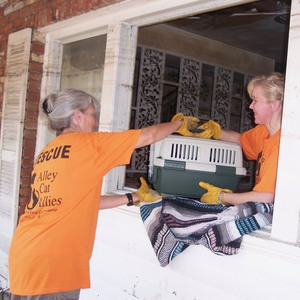
Shelter Success Simplified
Humane Network

1 Listener
All episodes
Best episodes
Top 10 Shelter Success Simplified Episodes
Goodpods has curated a list of the 10 best Shelter Success Simplified episodes, ranked by the number of listens and likes each episode have garnered from our listeners. If you are listening to Shelter Success Simplified for the first time, there's no better place to start than with one of these standout episodes. If you are a fan of the show, vote for your favorite Shelter Success Simplified episode by adding your comments to the episode page.

How to handle negative reviews, comments, stories - Ep57
Shelter Success Simplified
09/13/21 • 31 min
GUEST: Mark Robison has been president of CockadoodleMoo Farm Animal Sanctuary for more than 14 years. He is also Senior Consultant at Humane Network and Communications Manager for Options Veterinary Care, a nonprofit clinic. Mark was a journalist for more than 25 years in Stockton, California; Little Rock, Arkansas; and for most of his career at the main newspaper in Reno, the Gazette-Journal
MAIN QUESTION: How should nonprofit animal organizations handle negative reviews, critics on social media posts, and critical investigative reporters?
TAKEAWAYS:
- Respond to all online reviews, including the positive ones.
- Make sure that the person responding to negative reviews understands the big picture and can write clearly and concisely. This person may be you – or you might want to approve responses to negative reviews before they go out. Remember that the response is not just to this individual, but to everyone who will come across the review.
- Respond seriously to criticism, even when it’s unfounded. Express understanding for critics’ concerns.
- Cultivate supporters on social media by regularly liking their comments and responding to their praise and questions quickly. Be transparent and get ahead of criticisms so that your fans understand the issues and background.
- Hide comments by trolls, and respond fully to people who seem genuine in their concerns. Your main audience is not so much the critic as it is everyone else who might come across the complaint. This will give talking points for your fans so they can respond on your behalf wherever they encounter critics in the future.
- Don’t take journalistic investigations personally and don’t stonewall or be defensive. Express solidarity with their desire to inform the community and do right by supporters. Being open and honest will often defuse a reporter’s concerns before a situation blows up.
LINKS:
- Humane Network — website
- CockadoodleMoo Farm Animal Sanctuary — Facebook page
- Options Veterinary Care — website
- Leadership recommendation (article): “Managers: Compassion and Accountability Aren’t Mutually Exclusive" by Amy Gallo for Harvard Business Review

1 Listener
1 Comment
1

How to propose or best support a cat declaw ban - Ep37
Shelter Success Simplified
03/30/21 • 27 min
GUEST: Dr. Jennifer Conrad is the founder of The Paw Project, which educates the public about the painful and crippling effects of feline declawing and actively advocates to legally ban declawing at the community and state level. She is currently working in Southern California with nonprofit wildlife sanctuaries for unwanted and abused animals and administering her own company, Vet to the (Real) Stars, which provides humane veterinary care to animals appearing in television and movies. Dr. Conrad has spent more than two decades working on six continents to protect and improve the lives of wild animals. She is a graduate of the UC Davis School of Veterinary Medicine and is a member of the American Veterinary Medicine Association, the American Association of Zoo Veterinarians, and the European Association of Zoo and Wildlife Veterinarians.
MAIN QUESTION: What can animal welfare organizations do to make sure efforts to ban declawing of cats are successful?
TAKEAWAYS:
If you would like to see legislation banning declawing in your state or community, be sure to reach out to the team at Paw Project – Pawproject.org – which can help you with airtight language for your proposal. This is important because it’s easy to have proposed legislation get amended with exceptions that make it worse than no new legislation at all. It’s better to kill such bills than let them be passed, where they could enshrine into law the practices you are trying to end.
State veterinary medical associations tend to be the only ones to oppose declawing bans. They are trade organizations concerned primarily with the financial wellbeing of businesses, not with what’s best for the animals.
Veterinary medical associations have pushed a number of myths and outright lies. These include:
~ Myth: Declawing is necessary to protect babies and seniors with thin skin from being scratched. The truth is that declawing makes cats far more likely to bite. A cat scratch is a relatively minor issue but a bite can be much more serious because they more easily lead to infection. For this reason, the CDC does not recommend the declawing of cats to protect human health.
~ Myth: If declawing it not available, cats will be dumped at shelters by people in even greater numbers. This can be demonstrated as untrue in two ways. First, nearly all animal shelters oppose the declawing of cats because they know it results in behavioral issues such as urinating outside the litter box and biting – that really are common causes for cat surrenders to shelters. Second, the documented results of declaw bans show that shelter admissions decline after the practice of declawing is eliminated in a community.
The best thing animal shelters and rescues can do to support a proposed ban in your state is to write a letter in support of banning declawing on your own organization's letterhead and send it to the legislators – including the bill sponsors. Such letters are used in the “bill analysis” when legislators first see the proposal. It demonstrates support to legislators that makes it more likely they will back the legislation.
LINKS:
The Paw Project or email [email protected]
For Nevada residents to comment on proposed declaw legislation:
~ Select bill AB209 https://www.leg.state.nv.us/App/Opinions/81st2021
~ Email the bill's sponsor Assemblywoman Susan Martinez with "AB209 SUPPORT" in the subject line at [email protected]
Leadership recommendation: Future Fundraising Now blog and newsletter

Get staff and public buy-in for return-to-field - Ep68
Shelter Success Simplified
02/28/22 • 32 min
GUEST: Scott Giacoppo. Scott is the Director of National Shelter Outreach for Best Friends Animal Society and oversees the development of lifesaving efficacy and sustainability for animal welfare partners across the U.S. Prior to Best Friends, Scott was president of NACA – the National Animal Care & Control Association – as well as chief of Animal Field Services for the District of Columbia for 10 years, overseeing all animal control and cruelty investigations team members for Humane Rescue Alliance. He began his animal protection career with the Massachusetts Society for the Prevention of Cruelty to Animals as the Special State Police Officer for Cruelty Investigations.
MAIN QUESTION: How can leaders and managers get staff and public buy-in for return-to-field programs?
TAKEAWAYS:
- Removing cats doesn’t work, never has and never will. Removing a cat is not serving the community; it’s clearing a call log. It only solves the problem for a few weeks at most, as new cats will invariably move in to fill the void.
- Give your team all the information they need to fully understand why RTF is a better approach, how it works in other communities and why the old way is not effective.
- Some staff may be resistant to change because they don’t want to face the fact that they’ve been doing something that doesn’t work or because doing something new that goes against the way they have always done it can be scary.
- When someone calls to have cat picked up, that’s when the discussion about RTF should start. Explain that:
- Removing cats isn’t effective, as another cat will show up to fill the niche.
- Getting the cat fixed, vaccinated and returned decreases nuisance behavior, including spraying, yowling and fighting as well as preventing the birth of kittens.
- Share humane ways to deter cats from their garden or yard.
- When an officer has an encounter that doesn’t work out well, talk it through with them, asking them how it may have been handled differently and offering suggestions.
LINKS:
- Best Friends Network
- Leadership recommendation: Leadership Freak blog

How to keep an eye on your organization's mission - Ep55
Shelter Success Simplified
08/31/21 • 37 min
GUEST: Rebecca Guinn is CEO of LifeLine Animal Project, which manages Atlanta’s Fulton and DeKalb County animal shelters and which opened a new shelter, adoption center and clinic in 2019. LifeLine’s community outreach effort provides free vaccines, spay/neuter and other assistance to thousands of pets belonging to underserved Atlantans. LifeLine’s community cat program, the first and largest organized trap-neuter-return assistance program in Atlanta, has sterilized and vaccinated more than 40,000 community cats; and the LifeLine Spay & Neuter Clinics comprise the largest spay/neuter provider in Georgia, having performed more than 140,000 surgeries to date. Rebecca is active in the Animal Law Section of the State Bar of Georgia and is a member of Best Friends Animal Society’s No-Kill 2025 National Steering Committee.
MAIN QUESTION: How can animal welfare leaders and managers keep an eye on the big picture while staying on top of day-to-day fires?
TAKEAWAYS:
- The leader’s job is to keep the focus on the mission and to get others involved in it.
- Build a team of likeminded people, look for each person’s superpower and tap into it.
- Seek out people with skills that complement others on the team.
- We owe our best to the animals every time. Set that standard for yourself.
- Find the gaps in your community, and figure out what’s needed to close those gaps.
- Regularly ask yourself if you're solving the right problems and what you are trying to make better. Perform gap analyses; over time, you’ll get better at solving for the right problems.
- Embrace both ends of the leash.
LINKS:
- Lifeline Animal Project — website
- Leadership recommendation: Nonprofit Tech for Good website and e-newsletter

Learn about new initiative for lost-found pets - Ep33
Shelter Success Simplified
02/19/21 • 29 min
Guest: Susanne Kogut is president of the Petco Foundation. She started out in corporate law before her passion for animals led her to become executive director of the Charlottesville-Albemarle SPCA. She is also vice-chair of the board of trustees for HABRI, the Human Animal Bond Research Institute.
Main question: How does Petco Foundation's new lost-and-found-pets initiative work, and why should shelter organizations participate?
Takeaways:
1 in 3 pets will be lost during their lifetimes, about 10 million each year.
Because supporting the human-animal bond is a fundamental part of our missions, getting them back home should be a priority for animal welfare organizations.
Petco Foundation is creating a national database and leveraging pet facial recognition technology so that there is one central place to seek help with a lost or found pet, making a successful outcome more likely. Dogs and cats are included.
It’s free to sign up and connects with many existing shelter management software platforms.
Grant opportunities are available to encourage groups to sign up so that their animals are included in the database. Additional grants are available to help organizations get animal management software if they don’t already. See Petcofoundation.org/findingrover for details.
“Stray” can have negative connotations so consider using “lost” or “missing” to describe pets who are found or picked up.
And lastly, it’s important not to make assumptions about pets who come to your organization looking rough. Such pets very well may come from loving families but being out in the elements or underlying health issues may give a false appearance of neglect.
Links:
Signup and details for Petco Foundation lost-and-found-pets initiative: https://www.petcofoundation.org/findingrover
Leadership recommendation: Tips on using Martha's Rules for board and other meetings
Recorded February 16, 2021

End-of-year fundraising tips and ideas - Ep26
Shelter Success Simplified
11/19/20 • 27 min
Guests: Humane Network CEO Diane Blankenburg and Humane Network president and Shelter Success Simplified podcast co-host Bonney Brown
Main questions: Why is fundraising so important in the final six weeks of the year, and what can people do to be more effective in their year-end fundraising?
Takeaways:
Fundraising is like retail sales – most donations come in at the end of the year.
Dec. 1 is biggest online fundraising day of the year, and the last week of the year, especially Dec. 31, are also extremely big for donations.
Make sure it’s easy to donate to your organization. You can test this by trying it out yourself with a small donation.
Matching programs greatly boost donations. This is different than company-match programs. Instead, this is where a donor – likely someone who was planning to give a large donation anyway – agrees to match donations. This inspires the top donor as well as the smaller donors because they know their money will go even further.
One fun easy idea is to highlight your favorite 12 saves or rescues of the year over 12 days in December.
And be sure to focus on individual animals in the stories you tell. These are more meaningful to donors than stories about your overall efforts or the overall need in your community.
Links:
Video of end-of-year fundraising webinar
PDF of end-of-year fundraising presentation
Leadership recommendation - "Strategic Planning: Five Steps to a More Secure Future”
Recorded November 18, 2020

How to create a good nonprofit board of directors - Ep22
Shelter Success Simplified
10/26/20 • 34 min
Guest: Jill Vacchina-Dobbs is the executive director of SPCA of Northern Nevada. She graduated with honors for UC-Santa Barbara and Gonzaga Law School. As a lawyer, she focused on transactional law, including nonprofit law. She served on the board of Humane Society of Truckee-Tahoe for 10 years, six as president.
Main question: How can organizations cultivate a good board of directors that has a positive relationship with the executive director or CEO?
Takeaways:
Positive work culture starts at the top so it’s important that the board’s relationship with the executive director or CEO is healthy and positive (but not a rubberstamp).
If the CEO/board relationship is not good, the president and CEO should meet and come to agreement on the objectives of the organization and candidly address concerns on both sides. Create processes that address concerns, such as financial checks and balances to re-establish trust.
When recruiting new board members, consider the needs of the organization. Seeking a CPA, attorney, marketing person or perhaps someone who is well connected can help you be more successful.
Set clear expectations in writing for board members such as donating annually, attending certain events, missing no more than 10% of meetings, etc. Have them sign it. This creates an impersonal basis for discussion if there are issues in the future.
Create an orientation process for new board members that includes the mission and goals of the organization.
Nonprofits need a fundraising board – every member needs to give money to the organization on an annual basis as well as help raise funds. This creates trust for potential donors.
Engage board members with positive stories about the organization’s good work, as you would other supporters.
Links:
Recommendation: Cal Newport's "Deep Questions" podcast
Recorded September 24, 2020

Tips for implementing new programs successfully - Ep65
Shelter Success Simplified
12/12/21 • 25 min
GUEST: Scott Giacoppo. Scott is the Director of National Shelter Outreach for Best Friends Animal Society and oversees the development of lifesaving efficacy and sustainability for animal welfare partners across the U.S. Prior to Best Friends, Scott was president of NACA – the National Animal Care & Control Association – as well as chief of Animal Field Services for the District of Columbia for 10 years, overseeing all animal control and cruelty investigations team members for Humane Rescue Alliance. He began his animal protection career with the Massachusetts Society for the Prevention of Cruelty to Animals as the Special State Police Officer for Cruelty Investigations.
MAIN QUESTION: What are the common issues you find when doing organizational assessments of animal organizations around the country?
TAKEAWAYS:
The two most common challenges to successfully implementing a program are internal communication and training. Scott shared tips on both:
1. Communication:
- Often when leadership decides to pursue a new program, by the time it trickles down to the frontline staff implementing it, the why is lost so staff members revert to doing what they know.
- Hold productive meetings that include explaining:
- Why the new program works, including a few examples from other places where it has helped and
- How the program is to be implemented.
- Create a culture of two-way communication, where people are encouraged to ask questions if they don’t understand.
2. Training
- Make training a priority. Investing time in training improves performance and increases staff retention.
- Schedule time to do it as a group. Watch a webinar together and discuss it, or schedule time to discuss assigned reading material.
- Engage staff in how a program is implemented – as this increases their buy in.
- For training resources check out the Best Friends Network Partners page – there’s a link in the show notes.
Scott also talked how frequently leaders and managers assume that things are going well and are unaware of issues. He suggested three ways to know what’s actually happening:
- Schedule time to routinely get out of your office and walk around and observe how things are being done and talk with your team.
- Plan an annual assessment – this could be a self-assessment or one conducted by consultants.
- Secret shopping your shelter: Call your own organization and ask a question to see how well (or not so well) your staff is doing helping people. Send a friend in to adopt a pet and have them tell you about the experience.
LINKS:
Leadership recommendations: "The Way We Think About Charity Is Dead Wrong" (TED Talk video and blog post)

Basics to know about animal shelter finances and HR - Ep25
Shelter Success Simplified
11/09/20 • 22 min
Guest: Chelsea Staley joined the Petco Foundation team as the Director of Lifesaving in May 2020. Chelsea oversees the Foundation’s grants team and supports animal welfare organizations nationwide. Before joining the Foundation, Chelsea served as the Executive Director of Kanawha-Charleston Humane Association in West Virginia. She also has an MBA from the University of Charleston.
Main question: What basics should shelter leaders know about finances and human resources?
Takeaways:
Essentially, nonprofits are businesses. Their mission is different, but they still only run well when using sound business practices.
Financial stewardship and trust with donors are crucial, so it can be worth contracting with a skilled bookkeeper and accountant.
Hire people who align with your mission. Recognize signs of stress in employees and reach out to them.
Progressive discipline or corrective action can be hard when you are starting out in a leadership role because most of us avoid conflict. Thinking about corrective action differently can help. You want the person to keep their job and, to do that, they need to follow protocols. You are offering them opportunities to grow as an employee. It’s your job to stand up for the animals. If an employee is dropping the ball, the pets can’t alert you. You need to monitor performance and speak up on behalf of the animals. It doesn’t have to be confrontational, but there need to be consequences for poor performance.
Links:
Leadership recommendation: Jim Collins' "Best New Year's Resolution? A 'Stop Doing' List"
Recorded Sept. 22, 2020

Help your community's dogs with separation anxiety - Ep 44
Shelter Success Simplified
05/27/21 • 21 min
GUEST: Kelley Bollen is a Certified Animal Behavior Consultant with a master’s degree in Animal Behavior who has worked in the field of companion animal behavior for twenty years. Kelley is the Owner and Principal Consultant for Kelley Bollen Consulting – an animal behavior consulting business that works with animal shelters across the country on the design and implementation of comprehensive behavior programs to improve the welfare of the animals. She leads Humane Network’s Alive & Thriving animal behavior training program for shelter and clinic staff. And Kelley teaches a new Animal Shelter Behavior Management Certificate Course through the University of the Pacific.
MAIN QUESTION: How can shelters and rescue groups help people in their community with dogs who have separation anxiety issues?
TAKEAWAYS:
- Actively reach out to the people in your community now (especially people who adopted a dog within the past year), with ideas to help them prepare their pets for when they return to work in an office in order to help prevent the development of separation anxiety.
- If a dog can’t be content in one room while their person is in another, then there will likely be problems when the person is outside the home for extended periods.
- Here are a few behavior tips to share with your community:
- Be low-key when you leave and when you return.
- Make your departure fun by hiding treats around the home and/or giving a Kong-type toy filled with mushy food, like canned pet food.
- Practice leaving and returning for increasing lengths of time, starting with 30 seconds, so the dog gets used to you going and coming back. Take the dog’s Kong when you return so the dog wants you to stay away longer.
- Leave a radio or TV on when you're gone to give the dog some company.
- Give the dog 10 to 15 minutes of aerobic exercise before leaving such as running up and down stairs or chasing a ball in the backyard.
LINKS:
- Kelley Bollen Consulting
- Video presentation on independence training for dogs by Kelley Bollen
- Separation anxiety behavior tips by Kelley Bollen that organizations can print and give to adopters or people who contact them with concerns
- Leadership recommendation: Sample fraud policy by the Association of Certified Fraud Examiners
Show more best episodes

Show more best episodes
FAQ
How many episodes does Shelter Success Simplified have?
Shelter Success Simplified currently has 69 episodes available.
What topics does Shelter Success Simplified cover?
The podcast is about Non-Profit, Dogs, Animal, Behavior, Management, Leadership, Cats, Pets, Nonprofit, Podcasts, Education, Leader, Business and Manager.
What is the most popular episode on Shelter Success Simplified?
The episode title 'How to handle negative reviews, comments, stories - Ep57' is the most popular.
What is the average episode length on Shelter Success Simplified?
The average episode length on Shelter Success Simplified is 25 minutes.
How often are episodes of Shelter Success Simplified released?
Episodes of Shelter Success Simplified are typically released every 7 days.
When was the first episode of Shelter Success Simplified?
The first episode of Shelter Success Simplified was released on Feb 27, 2020.
Show more FAQ

Show more FAQ